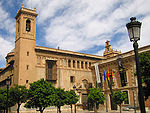Roman Catholic Archdiocese of Valencia in Spain
Religious organizations established in the 1490sRoman Catholic dioceses established in the 15th centuryRoman Catholic dioceses in SpainValencian Community

The Archdiocese of Valencia (Latin, Valentina) is a Catholic ecclesiastical territory located in north-eastern Spain, in the province of Valencia, part of the autonomous community of Valencia. The archdiocese heads the ecclesiastical province of Valencia, with authority over the suffragan dioceses of Ibiza, Majorca, Minorca, Orihuela-Alicante and Segorbe-Castellón. The archbishops are seated in Valencia Cathedral. On 28 August 2014, Pope Francis appointed Cardinal Antonio Cañizares Llovera as the next archbishop of Valencia.
Excerpt from the Wikipedia article Roman Catholic Archdiocese of Valencia in Spain (License: CC BY-SA 3.0, Authors, Images).Roman Catholic Archdiocese of Valencia in Spain
Plaça de la Reina, Valencia Ciutat Vella
Geographical coordinates (GPS) Address Nearby Places Show on map
Geographical coordinates (GPS)
| Latitude | Longitude |
|---|---|
| N 39.4758 ° | E -0.375 ° |
Address
Catedral de Valencia (Catedral de Santa María)
Plaça de la Reina
46003 Valencia, Ciutat Vella
Valencian Community, Spain
Open on Google Maps










